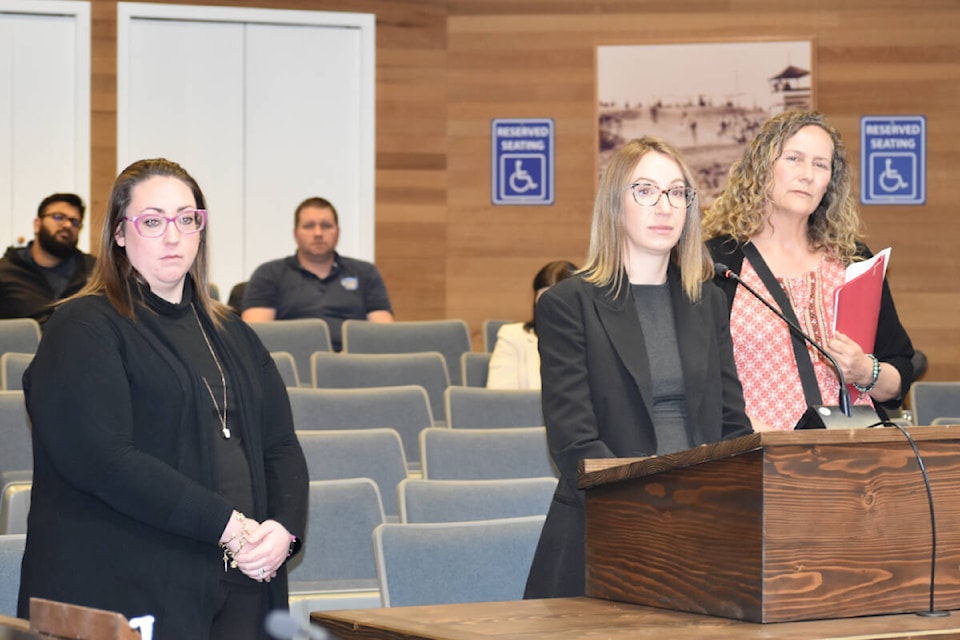There were nine toxic drug deaths in the Cariboo-Chilcotin in 2021, followed by an “alarming” amount more in 2022, an Interior Health Authority (IH) delegation told Williams Lake city council during its regular meeting Tuesday, April 26.
As a result of the 2022 overdoses, IH pulled a team together that has been meeting weekly to strategize and implement a response with the aim to keep people alive, said regional harm reduction co-ordinator Alison Houwelling.
Medical health officer Dr. Carol Fenton, and Katie Matuschewski were also part of the delegation who met with council.
Houwelling said a prescriber nurse has increased her outreach work and is partnering with an existing harm reduction worker in Williams Lake.
Supports have increased to the community action team (CAT) which consists of community, health authority, government and non-government members who meet monthly to discuss and plan strategies.
“Currently this group is forming an outreach team with lived experience to distribute Naloxone kits and harm reduction supplies in the evenings and on weekends,” Houweling said.
Street drugs are also being tested through the federal urgent drug testing service which involves people submitting samples to be tested.
A sampling done in April resulted in a toxic drug warning being issued on April 10.
READ MORE: Toxic drug alert issued for Williams Lake
IH also created the mental health and substance use crisis call number of 310-MHSU (6478).
Fenton said supervised consumption sites are a way to prevent deaths and many people are dying from smoking toxic drugs.
Naloxone is a life-saving tool and Fenton said if she had a high school aged child she would want them to have Naloxone on them, know how to use it and take it to social gatherings as a safe-guard.
A safe supply model, where substance users get a prescription at a local pharmacy, has worked for some people, but not for others, Fenton added.
“Some people are not ready to have that reliable relationship with a provider, some people are not comfortable with their name or personal health number being associated with drug use or sometimes they don’t have a good relationship with a pharmacy and do not feel comfortable.”
The goal is not necessarily to get people off drugs, but to stabilize them so they are able to function, feel good in their body and no longer have a disorder, she added.
“A lot of times we find abstinence-based programs make people more susceptible to overdose because they become then physiologically naive but they have not stabilized the reasons they use which are mental and physical pain or lack of connection.”
Provincial statistics Fenton shared showed 74 cent of the people dying from toxic drugs are between the ages of 30 to 59 and 78 per cent of them are males.
Fourteen per cent are First Nations and 12 per cent of are homeless, 86 per cent of the overdose deaths occur inside, 56 per cent in a private residence and 29 per cent in another residence such as a group home or a shelter. Thirty-five per cent of the people who died were employed - 50-plus per cent in trades, transport and equipment operator type jobs and 44 per cent were on social assistance.
“It’s important to reflect on these numbers and what they mean and how they differ to the stereotypes we hear. Most people are concerned about the overlap of mental health, homelessness and these things but when you look and only 12 per cent of these people were homeless it doesn’t reflect the stereotype,” Fenton said.
The crisis is worsening because drugs available on the street are unpredictable with potencies that are variable.
It is very difficult to know how much to use that is not going to be dangerous, particularly for first time users.
There is no labelling process, no quality control and people are not able to get a safe supply.
In Williams Lake, there are services for substance use counselling both in a group and for individuals, crisis response, intensive case management for mental health and substance use and facility withdrawal management.
There is a nurse prescriber for opioid agonist treatment, 24/7 specific opioid agonist threapy treatment at the hospital and community crisis response nurse outreach.
Renner House continues to offer facility withdrawal management and the Boys and Girls Club does blood born illness harm reduction.
Local politicians can help remove the stigma of substance use, Fenton told council.
“We can reduce stigma when we understand why people use drugs,” Fenton said.
Howeling added stigma is a key barrier to people reaching out for help and why many people use and die alone.
Coun. Scott Nelson asked if there is a local treatment centre and Matuschewski responded that residential treatment programs do not exist in Williams Lake.
“We have a five-bed detox centre, which is Renner House. Detox is the first step in order to enter a treatment program,” she said adding there is also the after-treatment support program offered at Esket First Nation.
Coun. Craig Smith, who works with a local First Nation, said there are gaps in supports for people when they return from treatment to communities outside of Williams Lake.
When Coun. Jason Ryll asked how the stigma of safe consumption sites can be removed, Fenton said it is important to have the conversation about what does drug use actually look like.
“What are the risks to individuals in the communities versus the stereotypes? It’s really a gradual process about changing hearts and minds to get people to support each other.”
City council has the platform to help remove the stigma, she added.
READ MORE: More than 5 British Columbians died a day from toxic drug poisoning in March
news@wltribune.com
Like us on Facebook and follow us on Twitter
